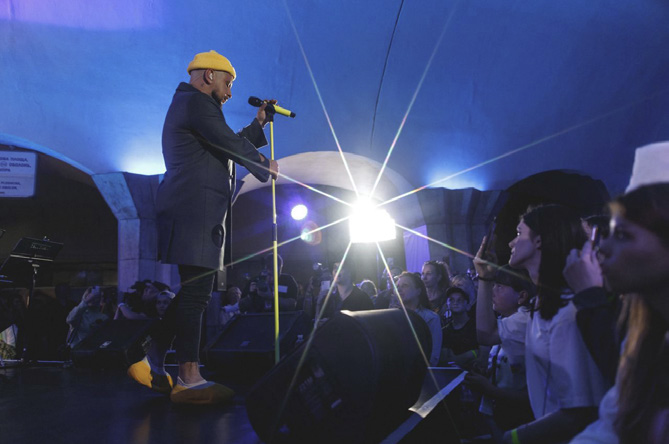We’ve all had terrible gigs, and likely some with the potential for something to go bad and impact the safety of the crew, artists, and audience is legitimately an issue. However, few folks in our business have to work around a war in progress, but that’s exactly what’s happening in Ukraine.
The country’s artists, production professionals, and entertainment industry are pitching in to raise morale and money to support the war effort, and ordinary citizens caught up in the conflict by mounting charity shows in a variety of settings in Ukraine and throughout Europe. As our contacts, Volodymyr and Pavlo, explained in the previous article (here), regardless of the situation they, their colleagues, and Ukrainians in general face, they refuse to “stop life.”
Today, December 23, Volodymyr is in RealMusic’s Kyiv office. He’s giving me a virtual tour – at the entrance, to see a generator. “Right now, we have electricity. When it disappears, we take the generator and put it outside. And this is the sign for the building address,” he adds, pointing downwards. “At the beginning of the invasion, it was revealed that Russians didn’t have navigators,” he says. “They had old maps, so people in Ukraine removed all their signs everywhere so the Russians will get lost.
“You should know, just recently, we had a double attack; one day rockets, and the next drones, so the whole Kyiv region didn’t have electricity for two days,” he adds.

Going Underground
In mounting concerts, everyone involved faces tremendous challenges, logistically and in terms of maintaining the safety of themselves, artists and audiences. The venues vary, but Metro stations were an obvious choice for offering more protection and the ability to keep both the setup and the shows from drawing unwanted attention.
The main goal is to raise funds for everything from supplies and generators for citizens to equipment and basic needs for the armed forces and part of a nationwide effort. “The nation is volunteering,” Volodymyr says straightforwardly. Essentially creating grassroots supply chains for “generators, backup power supplies, and many things. So, people who are able to travel to Europe use trucks and buses to deliver them across Ukraine.”
Metro stations are still operational, Pavlo says during a later call. They double as shelters during attacks and as concert venues for both Ukrainian and foreign artists wishing to support Ukraine. One of Kyiv’s centrally located stations, in particular, has been a go-to space. “It was closed from the first day of the war until December 21 for security reasons,” Pavlo explains. “The train still passed through the station but was closed for passengers.” Initially, the station was used for press conferences by Ukrainian leadership and later concerts.
One of the first shows held there was an acoustic performance by Bono. Since then, there have been other concerts – primarily by well-known Ukrainian artists. In many cases, the shows are recorded and streamed, allowing others to take them in owing to the “very small amount of people you can put in a Metro station,” Pavlo says.
Metro trains are also the only means of delivering gear for shows, which comes with logistical challenges and doesn’t mitigate the risk for those working the gigs. For example, Volodymyr cites a show on Ukrainian Independence day, August 24. “The Russians launched a huge airstrike on the day. So the people who worked on the load in/load out, they had a lot of courage to do this. There were nearly 80 rockets on that day. But there’s only one way to get this to the final destination station for the concert – You put everything in the train car at the last stop above the ground and carry it to the station.” He shares his screen, showing photos of a subway car full of racks and trusses from the show.

“Trusses and decorations are the most challenging things to operate in tough spaces. We literally had two centimeters (on each side) left when we loaded our biggest constructions in the metro car,” says Elena Ponomarchuk, head of the rental department for local rigging manufacturer/provider Alviss.
Since passengers are still using the Metro, the train cars are the same as they use, and gear must be unloaded quickly and hauled through the station, often via escalators. Elena praises the courage and endurance of their staff working tirelessly to set up and take apart show infrastructure – noting that, while prepping for one show, there was shelling in Kyiv and across Ukraine all day – 189 air alarms in all.
Other events have been held at the same station, including an April concert by Ukraine’s Okean Elzy, mounted to raise funds for children affected by the war and broadcast/filmed by 1+1 Media. “So millions of people could watch it and donate via charity platforms online,” says Oleksandr Kovtun, owner of the rental company, RestOne, which provided technical support for the show.
Owing to the size of the train cars, the layout of the station, and the need to use escalators to get the gear in, Oleksandr adds. “There’s very little time for setup, so all the work that could be done outside was done in our warehouse. It was possible to set up RF management in advance because the station is located deep underground, and there are no external sources of radio interference. All the necessary show, scene, and Dante network patches were also loaded before we went down.” In all, it took a day and a half to set up and required two separate crews working in shifts around the clock.
The subway overall, and this station, situated near the governmental hub of Kyiv, became a refuge for many people during the bombing of the capital. “It was not chosen by chance,” Volodymyr says, adding that for the April concert, the audience was made up of volunteers, medics, military personnel, employees of the State Emergency Service, the Ukrzaliznytsia (National Railway Management Service), and National Police – “all those working around the clock to bring victory for Ukraine closer.”
“In the middle of the concerts, you can hear the alarms warning that there are missiles in the sky,” Pavlo adds. “So, you need to do the concerts in the shelters – it’s the only way.”

Sobering Reality
Over time, there have been deaths and injuries in the production community, Volodymyr says. “One very sad case was a concert planned at a small venue in the center of a city in central Ukraine. The technicians were on stage a few hours before the concert, and the rockets hit. (The venue) and the gear was burned, one guy was killed, and another was seriously injured. They were part of a team from Kyiv. Everybody made donations to support the injured, to support relatives of the person who’d been killed.”
He adds that a local rental company recovered some (but very few) pieces of equipment that weren’t destroyed and mentions two professional distribution company facilities that were destroyed by rocket attacks early on in the conflict, as well as rental companies’ warehouses in cities in the north of the country. And in Kharkiv, specifically – areas not only shelled but occupied, and in the case of Kharkiv, ultimately liberated.
He pauses, then notes, “But we would be better to focus on the good things. We’ve had a lot of this shit happen, not only with our pro audio people but with everybody.”

Sharing resources with other companies in the audio industry when equipment is lost or unavailable is common. Obviously, with the country dedicated to the war effort, there is no compensation available. That is a matter for after the war. But what they can draw on is the solidarity of their professional community.
“As technicians, engineers, and performers, we work with what’s available and take whatever action necessary to get the gig done no matter what – we all have accumulated problem-solving skills to adapt to a given situation,” Volodymyr says.
Those skills are on full display in the metro shows. If I’d seen the photos without any context, I’d be hard-pressed not to look at them and simply admire the aesthetics of the shows. The fact is, they are using the space they have to work with ingeniously.
Sonically, however, the subway presents challenges, explains Andrew Zistan, Verka Serduchka’s sound engineer, sharing his experiences from a pair of shows in June by Serduchka and Nino Katamadze in the Kyiv metro – a filmed event he describes as “a manifesto of gratitude to the Ukrainian army, to the employees of the Ministry of Internal Affairs and State Emergency Service, to subway and railway workers, and the volunteers and doctors working tirelessly for our victory who’ve become real heroes.”
Andrew mixed both shows with an Allen & Heath dLive system consisting of a CDM32 mix rack, a DX32 modular stage box with PRIME IN cards with preamps, and a compact C1500 console for mixing.

“It is clear that the acoustic conditions at the metro station are far from ideal, but, as always, we decided to squeeze the maximum possible sound quality out of this situation both for the concert and for the TV version,” Andrew says. “The compactness of our dLive setup, in this case, was never as appropriate, and the quality of the preamps, effects and sound path of the system at the same time remained uncompromisingly high, so everyone enjoyed the driving sound, despite the difficult conditions of the concerts.”
More recently, shows have been mounted on retaken territory, Volodymyr adds, citing Ukrainian band S.K.A.I. “After the liberation of the south, they had the courage to go and have concerts in Kherson – less than 50 kilometers from the Russian side. I think those people, the artists who went to support the warriors and citizens, are very brave.”
And, despite the shelling of residential areas and critical infrastructure, they continue touring Ukraine and abroad. “In November and December 2022, S.K.A.I. played around 20 shows in Ukraine, including that visit to Kherson.”
The Show Must Go On
The next leg of touring, through January 2023, is dedicated to the mission of raising funds for the military and bringing victory closer under a slogan that, in English, means ‘help-and-win’. “We’ve faced a number of difficulties caused by the war,” says Andriy Danko, S.K.A.I’s monitor engineer. “Firstly, only venues equipped with bomb shelters are suitable for holding concerts. Obviously, there are not so many, so the number of audience members can’t exceed the capacity of the shelter.”

It’s not uncommon for everyone to need those shelters, he adds. “In the event of an air raid alert, all audience and crew must immediately leave the venue and remain in the bomb shelter until the alarm ends. We repeatedly encountered that, but the band went into the shelter with the audience and did unplugged concerts. Then, after the alarm ends, everyone comes out, and the show continues.”
Shows must also end no later than 9:30 pm to allow everyone to get home before the general curfew of 11 pm, and power outages are, unsurprisingly, common. Andriy: “Due to the shelling of Ukraine’s energy system, any moment we risk power cut-offs, so we always have a backup diesel generator nearby, so we can quickly switch – we were forced to do this several times. But, despite all the efforts of Russians to kill us, the show must, and will, go on.”
“It’s started to be normal to stop in the middle of a song,” Pavlo continues, under and above ground. “We had an big charity concert in Kyiv with 3,000 people. In the middle of a song, everything stopped, but no one even thinks about technical troubles. They just say, ‘OK, I think it’s an electricity outage. Let’s wait,” he adds, laughing. “Everyone just waits.”
Beyond the shows in Ukraine, artists are still hitting the road in Europe and elsewhere to raise funds, including Verka Serduchka, who will be touring North America in 2023. Okean Elzy has also been active outside Ukraine, Volodymyr notes, showing photographs from a show in one of the city’s prominent venues, Le Zénith Paris, “which never had performances by Ukrainian artists before.”
Entitled #HelpforUkraine, the tour took in several cities, says Max Bartashuk, one of Okean Elzy’s technicians. While the gear they used differed from country to country, what did not alter, he sums up, was how they were greeted: “Our technical staff has always been treated well, and there is huge support and solidarity with our people in these difficult times everywhere.”
In roughly six months, Okean Elzy has raised more than $850,000 USD for direct help for the Ukrainian State Emergency Service, Armed Forces, and military medics, as well as for children who are suffering during the war. Among the hard assets they’ve helped fund are drones, inverters, batteries, generators, medical supplies such as surgical and laparoscopic sets, hemostatic tourniquets, as well as laptops and tablets for distance learning, as well as a fire truck that was purchased, and sent to recently liberated territories for emergency service dealing with ongoing shelling in the area.

Moving Forward
Similarly, another iconic Ukrainian pop artist, MONATIK, has volunteered, collected humanitarian aid, and engaged in educational efforts while continuing his ‘ART Oborona’ world tour to raise funds for the needs of Ukraine’s Armed Forces and civilians alike. Over 10 months via ART Oborona, various partner projects, concerts, and his own funds, he has helped raise over 20 million hryvnias (almost 500,000 euros).
“Usually, our team prepares for concerts and international tours in advance. Sometimes for more than a year,” says Andriy Kapitanets, MONATIK’s sound engineer, “making dozens of recordings, doing musical runs, so everything sounds perfect for the audiences and shows the high level of the ‘Made in Ukraine’ show program.
“While the same prep couldn’t be undertaken for recent shows, Dima (the artist) supported us from the first days of the war. He stayed in touch and continued to pay our salaries.” The preparations for the large-scale world charity tour “ART Defense” tour encouraged us,” he adds. Our work not only continues but is socially significant and brings benefits to our country. This year showed that Ukrainians cannot be broken, and the cultural frontline became extremely strong and powerful.”
Owing to the help of various manufacturers and production houses, MONATIK has been able to present a high degree of production quality, he adds, citing gear from companies including d&b, L-Acoustics, Meyer Sound, DiGiCo, Allen & Heath, and Yamaha.
When it comes to shows in Ukraine performed for military units, volunteer organizations, and in hospitals, Andriy Kapitanets explains, “Due to the realities of war and security requirements, it’s essential to work on small ‘mobile’ sound setups or play completely acoustically. However, MONATIK’s ART Oborona concert in Kyiv’s Metro was an exception: “Thanks to the work of Ukrainian rental companies, in an acoustically extremely difficult venue, it was possible to unite the artist with string and wind quartets. The whole orchestra played for the military, volunteers, doctors, and electricians – those who defend our country every day.”

There is a long list of Ukrainian artists who makes equal efforts with a national volunteering idea: TNMK, Boombox, Hardkiss, Tartak, Kalush, Artem Pyvovarov – and many others. For those unfamiliar with the artists mentioned here – as many no doubt are – preoccupied as we are with English language artists in North America, it’s important to note how high their profile is domestically and how committed artists are to aiding the war effort, Andriy Danilko (Verka Serduchka) for example, recently auctioned off his Rolls Royce, once owned by Queen’s iconic singer Freddie Mercury and raising 250,000 British pounds, with all proceeds donated to the construction of the modern Superhumans center, which will aid in the rehabilitation of adults and children affected by the war.
“Verka, together with her band, also did a big tour, which started in Europe,” Andriy Danilko notes. “Often the technical and domestic conditions are very complex, from simple street concerts to large shows broadcast on television. So, in order to be minimally dependent on complex technical conditions, the artist’s technical team decided to take a large part of their setup with them. As previously mentioned, including the A&H dLive setup used in the Metro.
“Many Ukrainian artists went on concert tours around the world to collect aid for the Armed Forces of Ukraine and Ukrainian refugees,” Andrew Zistan says. As we say in Ukraine now, there are no small donations; every euro or dollar is important and will help in some specific matter.”
So too, is every effort by whoever is making it, Volodymyr sums up, explaining that it’s not just the well-known, accomplished Ukrainian acts using their talents to help. Ukraine’s cultural community and entertainment business have mobilized – as artists, but also, in many cases, as fighters as well, some, he adds, who, along with others in Ukraine’s entertainment business, are doing both. But that’s something we’ll take up in more detail in another article.
In the background, I hear someone call out, “We’re waiting for you.”
“You’re ready?” Volodymyr replies, adding, “I’m sorry to be so short today.”
Obviously, no apology is necessary. Before signing off, we make plans to follow up in the new year and wish each other well.















